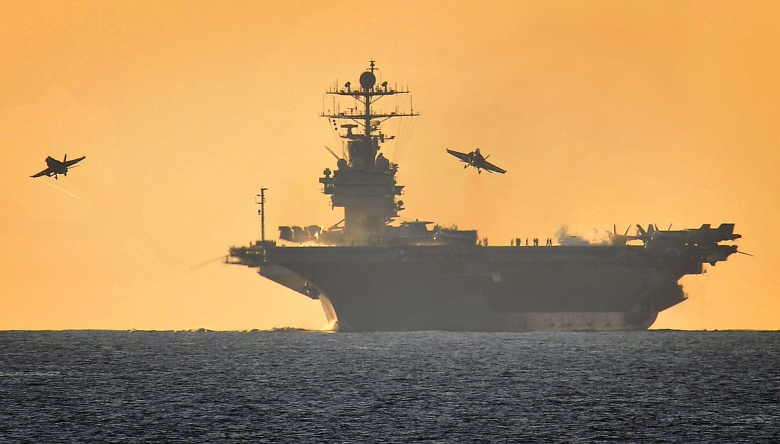為什麼美國軍方越過在中國的航空母艦殺手導彈,是不是在應急模式反應?。美國海軍將不得不忍受中國反艦彈道導彈,威脅航母的潛在的擴散。

The United States Navy will have to live with the proliferation of anti-ship ballistic missiles that have the potential to threaten an aircraft carrier. However, the threat from such weapons is not insurmountable, and in many cases, the danger might be overblown.
“I think there is this long-range precision strike capability, certainly. Everybody says A2/AD [anti-access/area-denial],” Adm. John Richardson, the U.S. Navy’s chief of naval operations, told an audience at the Center for a New American Security’s annual conference on June 20. “A2/AD is sort of an aspiration. In actual execution it’s much more difficult.”
While U.S. Navy officials—and many Washington, D.C., think tanks—have talked about the potential threat to the service’s aircraft carrier fleet from weapons such as the Chinese DF-21D and DF-26, the difficulty of developing a true A2/AD capability is seldom discussed.
As Richardson pointed out, A2/AD strategies have existed since the dawn of warfare. What makes the new Chinese capability different is the combination of intelligence, surveillance and reconnaissance (ISR) capability with long-range precision weapons. “The combination ubiquitous ISR, long-range precision strike weapons take that to the next level,” Richardson said. “It demands a response.”
But the threat is not just contained in the South China Sea, Richardson said. The anti-ship ballistic missile threat is increasingly found around the world and will continue to proliferate. Indeed, the hermit kingdom of North Korea has apparently acquired anti-ship ballistic missile technology. As such, the Navy will have to get used to living with the threat of anti-ship ballistic missiles and other similar threats.
“I think that the proliferation of anti-ship ballistic missiles is just a fact of life we’re going to have to address,” Richardson said. “That fact that it’s in the hands of North Korea—a leader who has been less predictable than many others brings another dimension to that equation.”
However, that does not mean that the aircraft carrier is obsolete or that the carrier air wing is unable to conduct its mission. As Navy officials have mentioned repeatedly in private conversations—weapons such as anti-ship ballistic missiles require an extensive “kill chain”—including ISR sensors, data-networks, command and control and other systems—in order to be effective. That extensive kill chain can be attacked and disrupted through electronic attacks, cyber warfare or some other kinetic means. “Our response would be to inject a lot of friction into that system,” Richardson said—disrupting the enemy kill chain.
Indeed, when A2/AD zones are discussed, often the entire radius of where an enemy missile can attack targets—such as an aircraft carrier out at sea—is marked as a no go zone. But in the Navy’s view, it can operate inside those zones, but the service would have to use different tactics. Moreover, the assumption that an area defended by a weapon such as a DF-26 is a no-go zone makes the implicit assumption that the Chinese—or other enemy—has the ISR assets and networks to make their weapon work perfectly. “That’s just not the reality of the situation,” Richardson said.
Nonetheless, anti-ship ballistic missiles and China’s growing A2/AD capabilities will remain a potential threat. But that threat is not insurmountable and will not render America’s mighty super carriers or their air wings obsolete in the near future.
Here Is Why the US Military Is Not In Panic Mode Over China's Carrier-Killer Missiles.

然而,這種武器的威脅是不是不可克服的,在很多情況下,危險性可能被誇大了。

僅管在201606初夏之際,美國憾然的派出2艘核子動力航空母艦戰鬥群,駛向中國南海,展開耀武揚威封鎖圍堵式的軍事演習,中國以不變應萬變的戰略指導原則,從容不迫的應戰,從頭到尾全盤監控美軍雙航母動向因,為中國藉由北斗衛星系統,有效加鎖定美國雙航空母艦的動態位置,提供5度空間打擊模式,此外中國的DF-26 導向飛彈攻擊營,在海南島軍事基地,早已準備就序,隨時接獲命令,給予美軍雙航母嚴重的攻擊,這也就是說為什麼過去201606的2週以來,美國雙航空母艦戰鬥群,始終在菲律賓海域及中國南海公海的水域,進行所謂的雙航空母艦演習秀?
美國從未駛入中國領海否則自負嚴重的開戰後果.這與外界報導有極大的差距是否因為美元懼怕中國的DF-26 航空母艦殺手飛彈的攻擊而作罷? 美國截至目前為尚未有任何反制DF-26的計劃? 對於中國而言來一艘航空母艦個宰一艘,來2艘航母,宰2艘,賺到喇賺到爆?
美國太平洋司令部及國防部及5角大樓,在其演習秀之後的結案報告中透露出:中國南海,該區域由先進武器保護,如果中國DF-26導向飛彈營的假設是一個沒有禁區,那麼中國或者其他敵人擁有ISR資產和網絡聯合作戰模式,則使他們的武器的工作更完美。美國認為是這樣的遠程精確打擊能力,當然可以。大家都說A2 / AD [反介入/區域封鎖],“海軍上將,20160620報告美國安全年會,”A2 / AD是那種一個願望。在實際執行它要困難得多。
“
Here Is Why the US Military Is Not In Panic Mode Over China's Carrier-Killer Missiles.
<!--[if !supportLineBreakNewLine]-->
<!--[endif]-->


One of the surprising revelations from Chinese television announcers during the 3 September military parade marking the 70th anniversary of the end of the Second World War was that the newly revealed DF-26 intermediate-range ballistic missile (IRBM) may have an anti-ship variant.
In addition to conducting "nuclear counterattack" missions, the DF-26 could also attack "medium-size ships at sea" as part of "conventional long-range precision strike", said the announcer.
As the DF-26's estimated range is 3,000-4,000 km, this missile might enable the People's Liberation Army (PLA) to target US Navy formations in the "Second Island Chain" or out to Guam.